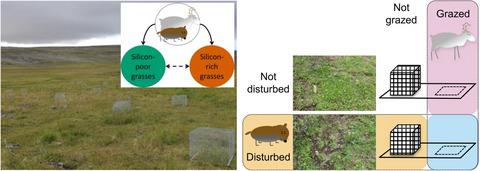Our official English website, www.x-mol.net, welcomes your feedback! (Note: you will need to create a separate account there.)
Forage quality in tundra grasslands under herbivory: Silicon-based defences, nutrients and their ratios in grasses
Journal of Ecology ( IF 5.5 ) Pub Date : 2021-10-08 , DOI: 10.1111/1365-2745.13790 Matteo Petit Bon 1, 2 , Katarina Gunnarsdotter Inga 1 , Tove Aagnes Utsi 1 , Ingibjörg Svala Jónsdóttir 3 , Kari Anne Bråthen 1
中文翻译:

草食性苔原草原的草料质量:草中的硅基防御、养分及其比例
更新日期:2021-10-08
Journal of Ecology ( IF 5.5 ) Pub Date : 2021-10-08 , DOI: 10.1111/1365-2745.13790 Matteo Petit Bon 1, 2 , Katarina Gunnarsdotter Inga 1 , Tove Aagnes Utsi 1 , Ingibjörg Svala Jónsdóttir 3 , Kari Anne Bråthen 1
Affiliation

|
- Herbivore-induced changes in both leaf silicon-based defence and nutrient levels are potential mechanisms through which grazers alter the quality of their own grass supply. In tundra grasslands, herbivores have been shown to increase nutrient contents of grasses; yet, it is an open question whether they also increase grass silicon-based defence levels. Here, we asked if, and to what extent, herbivores affect silicon content and silicon:nutrient ratios of grasses found in tundra grasslands.
- We performed an herbivore-interaction field-experiment spanning four tundra-grassland sites. At each site, we established reindeer-open and reindeer-exclusion plots in tundra-patches that had been disturbed or not by small rodents during the previous winter, for a total of 96 plots. We randomly collected over 1,150 leaf samples of inherently silicon-rich and silicon-poor grass species throughout a growing season and analysed silicon, nitrogen and phosphorus contents of each leaf.
- Small-rodent winter disturbance did not affect grass silicon content, but increased grass quality (i.e. lowered silicon:nutrient ratios) by enhancing nutrient levels of both silicon-rich (+20%–22%) and silicon-poor (+26%–34%) grasses. Reindeer summer herbivory increased the quality of silicon-rich grasses by decreasing their silicon content (−7%). However, the two herbivores together offset both these quality increments in silicon-rich grasses, thus reducing their quality towards the level of those found in the absence of herbivores and further enhancing their silicon:nutrient ratios (+13%–22%) relative to silicon-poor grasses.
- Synthesis. We provide the first community-level, field-based assessment of how herbivory-driven changes in both leaf silicon-based defence and nutrient levels alter grass-forage quality in tundra grasslands. Herbivores did not promote a net silicon accumulation in grasses, but rather enhanced their overall quality. Yet, the magnitude of these quality increments varied depending on the herbivore(s) involved and differed between silicon-rich and silicon-poor grasses. Such differential herbivory-induced changes in grass quality between and within tundra-patches may mediate plant–herbivore interactions by altering herbivore forage patterns and food choices. In tundra-patches utilised by both herbivores, the quality of silicon-rich grasses was further decreased relative to that of silicon-poor grasses. This could provide an advantage against herbivory, potentially being one of the pathways through which tundra-grassland vegetation states dominated by silicon-rich grasses are maintained by herbivores.
中文翻译:

草食性苔原草原的草料质量:草中的硅基防御、养分及其比例
- 草食动物引起的叶硅防御和营养水平的变化是食草动物改变自己草供应质量的潜在机制。在苔原草原,食草动物已被证明可以增加草的养分含量;然而,它们是否也能提高草硅基防御水平仍是一个悬而未决的问题。在这里,我们询问食草动物是否以及在多大程度上影响苔原草原中发现的草的硅含量和硅:养分比例。
- 我们进行了跨越四个苔原草原站点的食草动物相互作用现场实验。在每个站点,我们在前一个冬天是否受到小型啮齿动物干扰的苔原斑块中建立了驯鹿开放和驯鹿排除地块,总共 96 个地块。我们在整个生长季节随机收集了 1,150 多个天然富含硅和贫硅草种的叶子样本,并分析了每片叶子的硅、氮和磷含量。
- 小型啮齿动物冬季干扰不影响草硅含量,但通过提高富含硅 (+20%–22%) 和贫硅 (+26%– 34%) 草。驯鹿夏季食草通过降低硅含量 (-7%) 提高了富含硅草的质量。然而,这两种食草动物共同抵消了富含硅草的这些质量增量,从而将它们的质量降低到没有食草动物的水平,并进一步提高它们的硅:营养比(+13%–22%)相对于贫硅草。
- 合成. 我们提供了第一个社区层面的实地评估,以评估草食驱动的叶硅防御和营养水平的变化如何改变苔原草原的草料质量。草食动物并没有促进草中硅的净积累,而是提高了它们的整体质量。然而,这些质量增量的幅度取决于所涉及的食草动物,并且在富含硅和贫硅的草之间存在差异。这种不同的食草动物引起的苔原斑块之间和内部的草质量变化可能通过改变食草动物的草料模式和食物选择来介导植物与草食动物的相互作用。在两种食草动物使用的苔原带中,相对于贫硅草,富含硅的草的质量进一步下降。这可以提供对抗食草动物的优势,



























 京公网安备 11010802027423号
京公网安备 11010802027423号